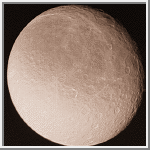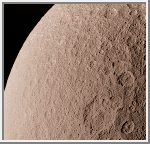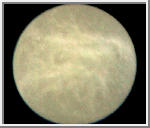 Rhea
Rhea Rhea
Rhea
Rhea [REE-a] is the largest airless satellite of Saturn. It was discovered in 1672 by Giovanni Cassini. Rhea is an icy body with a density of 1.33 gm/cm3. The low density indicates that it is composed of a rocky core taking up less than one-third of the moon's mass, with the rest composed of water-ice. Rhea is somewhat similar to Dione. They both have similar composition, albedo features, varied terrain and synchronous rotations. The temperature on Rhea is -174°C with illumation from the Sun and between -200°C and -220°C (-328°F and -364°F) in the shade.
Rhea is heavily cratered with bright whispy markings. Its surface can be divided into two geologically different areas based on crater density. The first area contains craters which are larger than 40 kilometers (25 miles) in diameter. The second area, in parts of the polar and equatorial regions, has craters under 40 kilometers (25 miles) in diameter. This suggests that a major resurfacing event occurred some time during its formation.

Discovered by ..................... Giovanni Domenico Cassini Date of discovery ...................................... 1672 Mass (kg) .......................................... 2.49e+21 Mass (Earth = 1) ................................. 4.1667e-04 Equatorial radius (km) .................................. 765 Equatorial radius (Earth = 1) .................... 1.1994e-01 Mean density (gm/cm^3) ................................. 1.33 Mean distance from Saturn (km) ...................... 527,040 Rotational period (days) ........................... 4.517500 Orbital period (days) .............................. 4.517500 Mean orbital velocity (km/sec) ......................... 8.49 Orbital eccentricity ................................. 0.0010 Orbital inclination .................................... 0.35° Escape velocity (km/sec) .............................. 0.659 Visual geometric albedo ................................. 0.7 Magnitude (Vo) .......................................... 9.7 Maximum surface temperature .......................... -174°C Minimum surface temperature .......................... -220°C

 Rhea
(GIF, 65K)
Rhea
(GIF, 65K)
This image of Rhea was acquired by the Voyager 1 spacecraft on
November 11, 1980.
(Credit: Calvin J. Hamilton)
 Rhea Up Close
(GIF, 558K)
Rhea Up Close
(GIF, 558K)
This high-resolution view of Rhea shows its heavily cratered crust.
Craters are found within craters. This image was taken by Voyager 1
on November 11, 1980.
(Credit: Calvin J. Hamilton)
 Rhea - Trailing Side
(GIF, 55K;
TIFF, 156K)
Rhea - Trailing Side
(GIF, 55K;
TIFF, 156K)
This image of the trailing side of Rhea
shows whispy terrain similar to Dione.
It was taken by Voyager at a range of 1.7 million kilometers.
(Credit: Calvin J. Hamilton)

